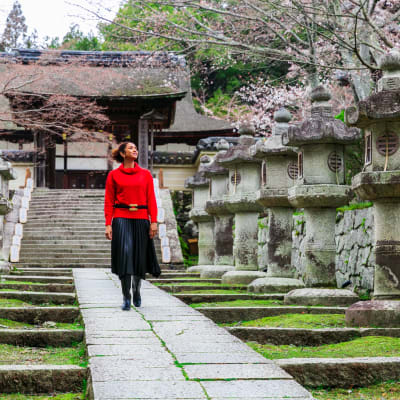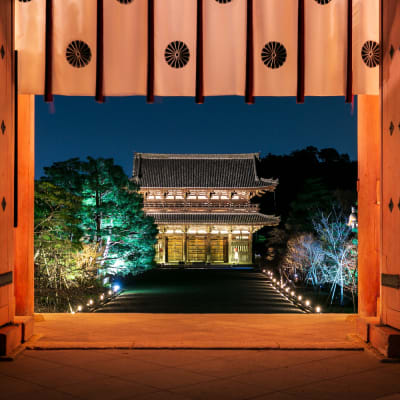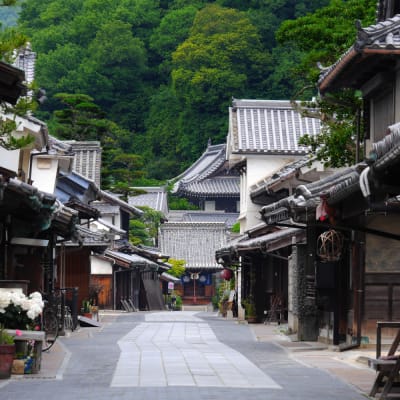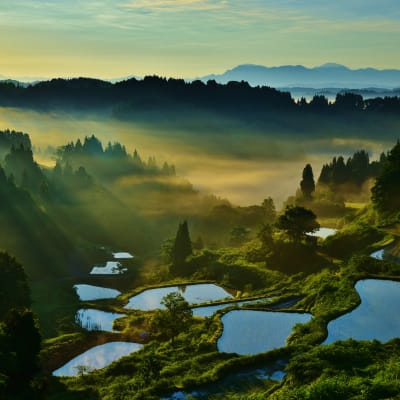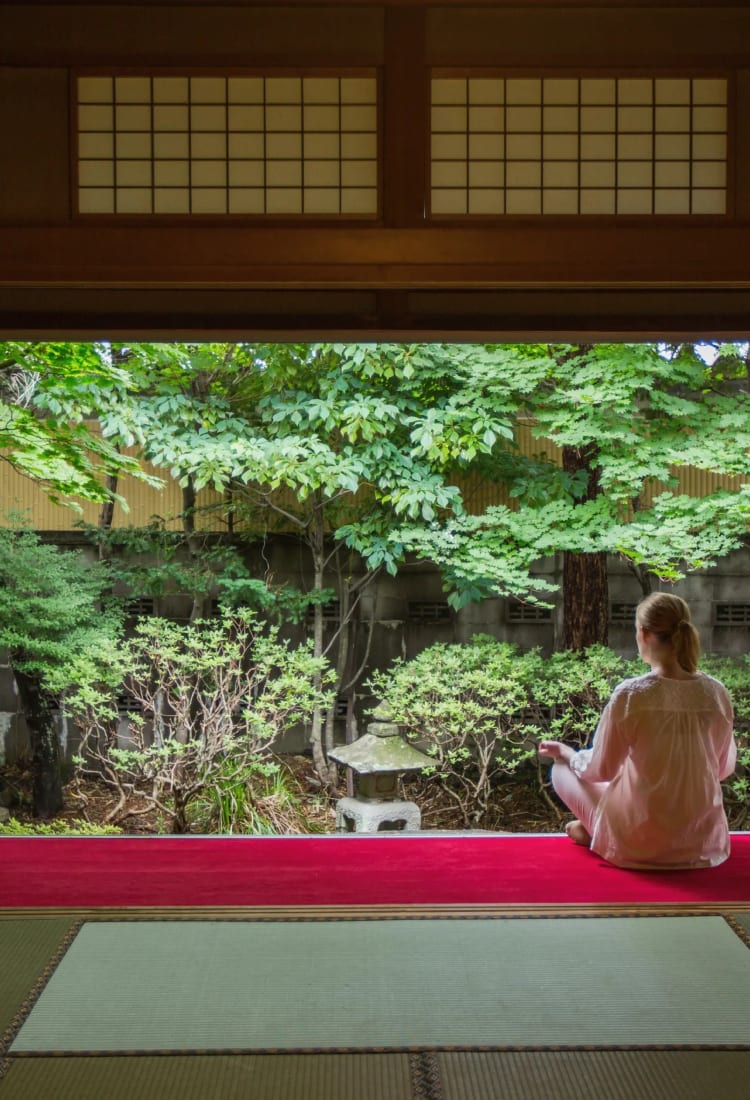
Temple Stays Temple Hotel Takayama Zenkoji A Wellness Retreat in the Heart of an Atmospheric Castle Town
Step off history-steeped streets into a haven of calm and tranquility
Temple Hotel Takayama Zenkoji is a quiet hideaway for spiritual repose. The temple is nestled inconspicuously in the heart of Takayama, a charming castle town in the western foothills of the Northern Alps, accessible by train from Nagoya. The peaceful sanctuary welcomes guests to recalibrate and experience life at a hospitable town-center temple. English-speaking priests are happy to guide guests in meditation, lead yoga sessions, or simply take a moment to talk, listen, or answer questions on anything from Japanese Buddhism to regional cuisine.

The temple’s main hall is lit with a welcoming glow at night.
This retreat within the quiet downtown area of Takayama is the perfect base to explore the rich history, long-standing traditions, and natural beauty of a renowned woodworking region, samurai stronghold, and mountain-ringed castle town. Stroll along the picturesque banks of the Miyagawa River which runs past the old town, and explore narrow streets lined with wooden merchant houses and centuries-old sake breweries. Visit one of many historic or cultural attractions such as Takayama Jinya, The Takayama Festival Floats Exhibition Hall, or the site of Takayama Castle. Venture out of the charming town center for unforgettable excursions to peaks in the Northern Alps, secluded hot-spring villages, or visit UNESCO World Heritage listed Shirakawa-go, a rustic hamlet with beautifully preserved thatched-roof farmhouses.

Takayama’s old town, a short walk from the temple
Experience the tranquility of temple life
Temple Hotel Takayama Zenkoji is an inclusive Buddhist temple that welcomes anyone, regardless of faith or nationality, to enjoy a calming break in a peaceful setting. The temple has five rooms that blend simple Buddhist charm with traditional Japanese style and comfort. Fragrant tatami flooring and delicate paper covered shoji screens offset wood-paneled ceilings and wooden furnishings. The rooms are available individually or can be booked together for a completely private stay.

Sleep peacefully in comfortable futon bedding on tatami flooring.

Guest rooms with views of the garden
The temple is equipped with modern amenities for a comfortable stay, from Wi-Fi and air conditioning to quality bedding and portable heaters. Guests can dine at the temple, choosing between shojin ryori, a vegetarian cuisine eaten by Buddhist priests, typically made using local wild plants, vegetables, and tofu; or regional Japanese cuisine featuring locally sourced ingredients.

Meals use local ingredients and are served on beautiful tableware.
Guests are welcomed with a friendly smile by an English-speaking priest and given a tour of the temple before being shown to their rooms. There are few rules, but it is worth noting that shoes should be removed at the entrance to the temple. The priests will provide friendly explanations of Japanese etiquette and customs to make you feel immediately at home.

The temple has comfortable communal spaces for chatting and relaxing.
Staying at Temple Hotel Takayama Zenkoji gives guests exclusive, behind-the-scenes access to the temple, but as with any place of worship, there are some sacred areas that remain off-limits.
Calm your mind through one of the temple’s exclusive experiences
The temple belongs to the Jodoshu (Pure Land) school of Buddhism, the most widely practiced school of Buddhism in Japan. It venerates Amithaba, the Buddha of Infinite Light, and is a branch temple of Shinshu-Zenkoji in Nagano, northwest of Tokyo.
Guests are invited to experience the temple and seek mindful repose through a selection of bespoke experiences, such as morning worship in the spiritual heart of the temple. It is held each morning in the main hall and participation is entirely optional, yet thoroughly recommended. The priest leading the service will give an overview before beginning, including an explanation of the sutra to be chanted. From the sweet aroma of the incense and the lyrical chanting to the opulence of the Buddhist altar, the service is a stimulation for the senses and a one-of-a-kind experience.

A guest playing singing bowls in the main hall, in front of the altar
Several priests at the temple are trained in yoga and can lead private sessions, catering to complete beginners or experienced enthusiasts. The temple’s tranquil setting makes it an ideal place to experience meditation. A priest will guide you attentively through the process, explaining posture and breathing techniques, placing an emphasis on comfort and relaxation.

Experience meditation, with friendly instruction from one of the priests.
Other experiences that can be arranged include shabutsu, the meditative tracing of Buddhist images such as of Amithaba, and singing bowl practice. Singing bowls are used during Buddhist practices such as meditation and produce rich and beautiful sounds when their rims are gently struck or circled with an accompanying mallet.

Shabutsu is a meditative experience, helping to calm the mind.
Savor flavors unique to the region
Feast on regional flavors at the temple and throughout Takayama. Temple Hotel Takayama Zenkoji offers shojin ryori, a vegetarian cuisine that has been enjoyed by Buddhist priests in Japan for centuries. A typical meal comprises several beautifully arranged dishes that feature wild plants, nuts, roots, bamboo shoots, mushrooms, and flowers. The dishes often include rice, tofu, and preserved vegetables seasoned with seaweed, vegetable oils, and miso. The cuisine emphasizes the natural flavors of the ingredients.

Beautifully presented shojin ryori
Priests at the temple can recommend restaurants in town that serve regional cuisine. Savor cuts of premium Hida beef, served seared as a mouthwatering steak; raw as a sushi topping; or served with miso, shiitake mushrooms, and green onions and cooked over a grill on a hoba leaf. Hoba is the name of a local species of magnolia, and the leaves from these trees have been used for preserving and cooking food in Takayama and the wider Hida region for centuries. The leaves do not burn easily and when heated, they lend an aromatic flavor to ingredients cooked upon them.

Vegetables being cooked with miso on a hoba leaf
Other popular dishes include Takayama ramen and keichan, chicken marinated in miso and cooked on a hotplate with onion, cabbage, and other vegetables. Pair Takayama’s local foods with its award-winning sake, brewed using locally grown rice, and water fresh from the mountains.

Sake on display outside a local brewery
Explore the rich history of the town
Takayama began as a castle town in the sixteenth century, ruled by Kanamori Nagachika (1524–1608), the feudal lord and ruler of the Hida region (the northern part of present-day Gifu Prefecture). The castle brought samurai, merchants, and tradespeople to the town, roads were built, temples and shrines were constructed, and the town flourished. In 1692 the Kanamori family’s rule of the Hida region came to an end, and Takayama came under the direct control of the Tokugawa shogunate, the feudal government that ruled Japan through the Edo period (1603–1867). The town continued to flourish and became a major commercial center, prospering from the region's valuable timber resources.

There are many historical buildings in Takayama, including the beautiful Takayama Jinya.
The town has retained much of its original charm and entire streets have been preserved to protect the local heritage. Former merchant homes line the streets of the old town, with many converted into shops, cafes, and restaurants. Many of Takayama’s sake breweries operate out of and around the old town, and offer sake tastings.

The facade of Sansya, a brewery in the old town, founded in 1855
The town is compact and easy to explore on foot. Walking five minutes from Temple Hotel Takayama Zenkoji brings you to Takayama Jinya, the opulent residence and offices of the shogunate-appointed provincial governor of Takayama. The palatial complex with its masterful timberwork, gently sloping eaves, and quintessentially Japanese garden exudes the traditional atmosphere of centuries-old Japan.

Step back in time as you explore the grounds of Takayama Jinya.
As you stroll the town look for wood-carved ornaments, lacquered tableware, and solid timber furniture. The Hida region has a rich heritage of woodwork that spans a millennium.
Uncover a centuries-old spectacle
Each year in spring and autumn a procession of handcrafted and ornately decorated floats weaves its way through the town, accompanied by the gentle beat of drums and the languid sounds of flutes and other traditional Japanese instruments. The Takayama Festival is one of the country’s most iconic festivals and is listed by UNESCO as Intangible Cultural Heritage. It has been held in the town for centuries, possibly even before the beginning of the Edo period (1603–1867).

Floats displayed at The Takayama Festival Floats Exhibition Hall
At The Takayama Festival Floats Exhibition Hall (Takayama Matsuri Yatai Kaikan) visitors can watch footage from the festival and view a large collection of beautifully adorned floats. Each is embellished with elaborate wood carvings, rich lacquering, and decorative metalwork, showcasing the artisanal heritage of the town and the Hida region.


Lion-like carvings around the wheel and colorful floral carvings beneath the eaves of one of the festival floats
Enjoy the rich natural environment
Takayama is surrounded by some of Japan’s tallest and most scenic mountains. The opportunities for reinvigorating outdoor excursions are limitless. Cycle through quiet farming villages and past rice fields, snowshoe through forests blanketed in virgin snow in winter, or hike to peaks in the Chubusangaku National Park such as Mt. Norikura (3,026 m) or Mt. Hotaka (3,190 m).

The view from a hiking trail on Mt. Norikura

Snowshoeing in the midst of winter
SATOYAMA EXPERIENCE
Satoyama Experience offers private excursions and custom tours aimed at connecting visitors with the Takayama countryside and the local culture. They operate tour desks at Takayama Station, a short walk from Temple Hotel Takayama Zenkoji, and in Hida-Furukawa, a small town just north of Takayama.

Touring the Takayama countryside on two wheels
SATOYAMA EXPERIENCE
No stay in the Japanese countryside is complete without a luxurious soak in the soothing waters of a natural hot spring. Northeast of Takayama in the foothills of the Northern Alps there are several secluded hot spring villages that offer peaceful bathing experiences in stunning surroundings. Fukuji Onsen (also known locally as Tennousen—The Emperor’s Springs) dates from the Heian period (794–1185) and is one of the most charming. Emperor Murakami (926–967) is said to have bathed here in the tenth century. There are several traditional inns in the area with shared and private bathing facilities, catering to overnight guests and day-bathers.

The Fukuji hot-spring hamlet, after the rain, at dusk
Okuhida Onsengo Tourism Association
Measures against the spread of COVID-19
Temple Hotel Takayama Zenkoji is taking measures to prevent the spread of COVID-19, including regularly disinfecting and ventilating rooms and shared spaces, and making alcohol hand sanitizers available.
Please note that certain programs and events may have been canceled or temporarily suspended due to COVID-19. Please check the temple website or inquire in advance.




















































